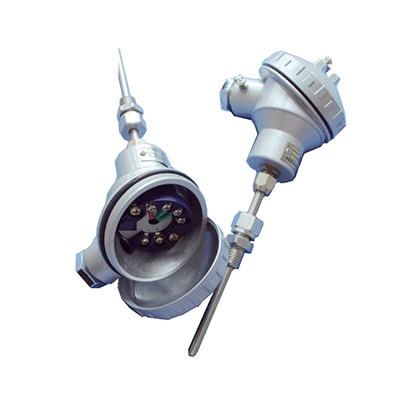Integrated thermal resistance (with temperature transmitter)
Description
I. application
Thermal resistance is usually used in conjunction with display instruments, recording instruments, electronic computers, etc., and outputs 4~20mA. Direct measurement of liquid, vapor and gas medium and solid surface temperature in the range of -200 to 500 C in various production processes.
Two, characteristics
1, the second line output is 4 to 20mA, and the anti-interference ability is strong.
2. Save the cost of compensation conductor and installation temperature transmitter.
3, the scope of measurement is large.
4, cold end temperature automatic compensation, nonlinear correction circuit.
Three, working principle
The resistance produced by the thermal resistor produces an unbalanced signal through the bridge of the temperature transmitter. After amplification, it turns into a 4 to 20mA DC electrical signal to the working instrument, and the working instrument displays the corresponding temperature value.
Four, main technical parameters
1, product implementation standards
IEC584
IEC1515
IEC751
JB/T5518-91
JB/T7391-94
2, temperature range and tolerance
Model | Graduation | Measuring range C | Accuracy grade | Allowable deviation |
WZPB | PT100 | -200-500 | Class A | (0.15+0.002[t]) |
Level B | (0.30+0.005[t]) | |||
WZCB | Cu50 Cu100 | -50-150 | (0.30+0.006[t]) |
Note: t is the measured temperature value of temperature sensor.
3, electrical parameters
(1) the output signal is 4 ~ 20mA, the load resistance is 250 ohms, and the resistance of the transmission wire is 100 ohm.
(2) output method: two-line system
4. Accuracy:
(1) accuracy of temperature transmitter: 0.1; 0.2; 0.5;
(2) display accuracy: analog indication 2.5 level; digital display level 1.
5, power supply: 24V.DC + 10%
6, protection level: IP65
7, insulation resistance: the insulation resistance between the terminals of the instrument output terminal and the housing should not be less than 50M ohm.
8, thermal response time:
When the temperature changes step by step, the current output signal of the instrument changes to 50% of the time required to achieve the step change. Usually, tau 0.5 indicates that when the step response time of the temperature transmitter is not longer than five of the thermal response stabilization time of thermocouple (resistance) 0.5, the thermal response time of the thermocouple (resistance) is used as the thermal response time of the instrument.
When the step response time of the temperature transmitter is not more than 1/2 of the thermal response stability time of thermocouple (resistance), the thermal response time of the temperature transmitter is used as the thermal response time of the instrument. 0.5.
9. Basic error
The basic error of the instrument should not exceed the synthetic error of the basic error of the thermocouple (resistance) and the temperature transmitter.
10. Working environment
Installation site rating | Temperature c | Relative humidity% | Atmospheric pressure KPa |
Cx1 | -25 ~ +55 | 5~95 | 86~106 |
Cx2 | -25 ~ +70 | ||
Cx3 | -40 ~ +80 |


